Menus
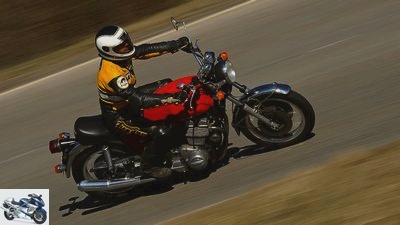
mutschler.foto@t-online.de
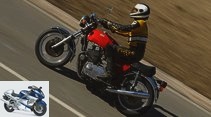

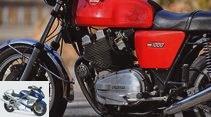
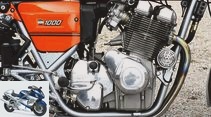
8th photos

mutschler.foto@t-online.de
1/8
Laverda 1000.
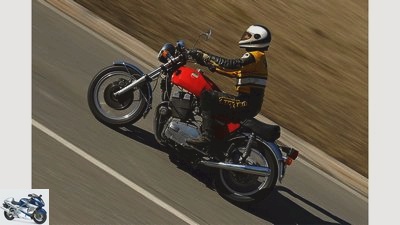
mutschler.foto@t-online.de
2/8
Laverda 1000.

3/8
Not everyone wore cast rims in 1976, the 1000 3 CL was one of the pioneers.
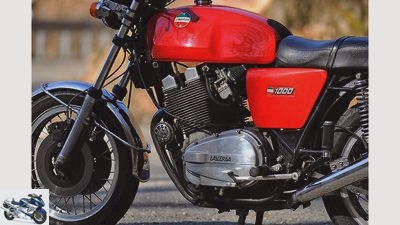
mutschler.foto@t-online.de
4/8
The massive and powerful engine remained the same as in the premiere model.
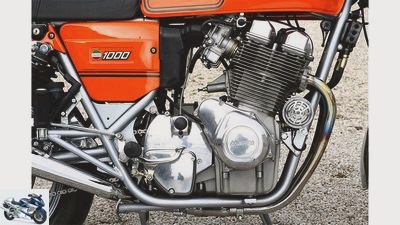
5/8
Laverda 1000.
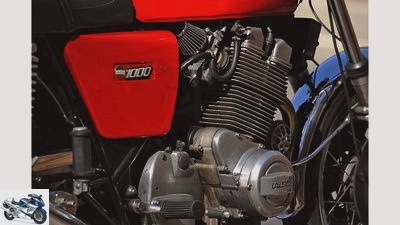
mutschler.foto@t-online.de
6/8
Laverda 1000.
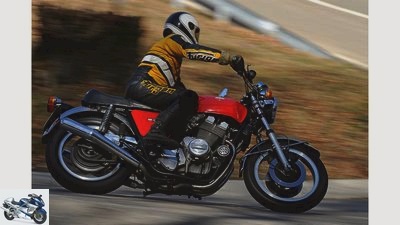
mutschler.foto@t-online.de
7/8
Laverda 1000.

mutschler.foto@t-online.de
8/8
Laverda 1000.
Cult bike Laverda 1000
And size does matter
Size matters, Massimo Laverda knew that before any other European, and so he began developing a 1000 cc superbike at an early age. The Laverda 1000 came a little too late anyway.
The venerable agricultural machinery factory L.averda from Breganze – to this day it is one of the most important suppliers of combine harvesters – has also built motorcycles since 1950. Initially with a modest cubic capacity, but when the founder’s great-grandson got involved in the company’s fortunes, awareness of performance increased. Massimo Laverda wanted to get involved in the profitable North American market, extensive on-site studies prompted him in the mid-1960s to start with 650 cc. So much displacement, he was sure, had to be shown in order to be recognized as a newcomer there. But even during the development phase of this first great Laverda, the demands rose. Massimo increased his twin to 750 cm³ and also commissioned chief technician Luciano Zen for a thousand.
Buy complete article

Cult bike Laverda 1000
And size does matter
Chassis stability had no weaknesses
But still not for sale. Instead, Kawasaki presented the 900 Z1 in 1972 and reaped the astonishment that Massimo had intended for his 1000 cc. It was not until the following year that he was able to switch from pre-production to series production, and many more months passed before German fans were served – by then two Brembo disc brakes had already replaced the overstrained front drum.
But it stayed with Borrani high-shoulder rims, and not a few consider these 3 Cs to be the most beautiful, even more beautiful than the 3 CL with rear disc brakes and cast aluminum rims. Externals! At the core of the experience is an engine who is considered one of the best character actors in his field. The two outer pistons race up and down in parallel, the middle one offset by 180 degrees, this ensures a unique sound. And increases the pulling power.
In fact, the torque curve of the 1000 Laverda climbs a 70 Nm plateau at 4500 tours, which it only leaves again at over 8000 rpm – even the Kawa had to fit. Unlike the Japanese, the chassis stability had no weaknesses, but the handling suffered from the high center of gravity and the suspension elements offered only rudimentary comfort. So you have to be able to grab hold of it in order to be quick, and everyone takes the aptitude test on the clutch: If you don’t have tendinitis after 50 kilometers, you can continue training.
Scene and information
scene
Only a few thousand were produced. It had discussed half the motorcycle world and dreamed of it – no wonder that the Laverda 1000 in all its versions is one of the most sought-after young timers. It was built until 1987, most recently as a 1200 model and with a 120 degree crank pin offset. The mechanical basis of the engine and chassis is really good; Ignition and alternator are weak points and are often replaced by better ones. Good copies quickly cost over 7,000 euros, great ones even more. Thanks to active specialists (www.octeam.de and www.laverda-paradies.de), service and spare parts supply are guaranteed.
info
The informative work “Laverda – the complete history from 1949 to 1989” by Jean-Louis Olive is only available as an antiquarian. The repair instructions at Bucheli about Laverda’s two- and three-cylinder (39.90 euros) are different. The exemplary website www.laverda-gemeinschaft-deutschland.de is very lovingly made.
Technical specifications
The one-liter three-cylinder of the Laverda 1000 delivers 78 hp. That’s enough for 209 km / h – lying down.
engine
air-cooled three-cylinder four-stroke dohc in-line engine, two valves per cylinder, 981 cm³,
52 kW (78 hp) at 7800 rpm, 75 Nm at 7000 rpm
drive
Primary drive via chain, five-speed gearbox, secondary drive via chain
frame
Double loop frame made of tubular steel
tires
front 3.50 x 18, rear 4.00 x 18
measurements and weight
Weight with a full tank 243 kg
Tank capacity 18 liters
Top speed lying down 209 km / h
0-100 km / h in 4.7 seconds.
Related articles
-
Air-cooled big bikes Kawasaki GPZ 1100 UT, Laverda RGS 1000 and Suzuki GSX 1100 EF
fact 48 pictures fact 1/48 The engines are the stars, they still exude charm and, in the case of GPZ, RGS and GSX, clearly inspire …
-
Comparison test Ducati 900 SS against Honda VTR 1000 against Laverda 750 S Formula
Comparison test Ducati 900 SS against Honda VTR 1000 against Laverda 750 S Formula Who dares, who twint Brand new and already in the large comparison…
-
BMW R 90 S, Kawasaki 900 Z1, Laverda 1000 3C Big Bikes
fact 30th photos fact 1/30 Big bike classics from the 70s – pure fascination. Kawasaki 900 Z1, Laverda 1000 3C and BMW R 90 S driven by MOTORRAD Classic….
-
Cult bike Norton Commando 750 Roadster
Warter cult bike Norton Commando 750 Roadster 1967 a real superbike Norton swung itself back to its old size for the last time and in 1967 created the …
-
archive 16 photos markus-jahn.com 1/16 Fished from the slide archive: Honda CBR 600 F (PC 31). fact 2/16 Fished from the slide archive: Honda CBR 600 F…
-
Dream bike choice Suzuki GSX-R 1000
www.factstudio.de 44 photos Suzuki 1/44 Everything about the technology of the Suzuki GSX-R 1000 in MOTORRAD 1/2005 (in stores from December 17th)….
-
Cult bike: Triumph Trident 900
Schwab 16 pictures Schmieder 1/16 The three-cylinder requires sensitivity, you have to put yourself in it. Schmieder 2/16 The oil channel of the left …
-
Jahn cult bike Yamaha RD 350 LC Yamaha RD 350 LC The two-stroke theme was through forever. Exhaust gas, noise, yes, yes, it’s okay, must be. Then came the end …
-
Cult bike Yamaha FZR 1000 Exup
Hartmann cult bike Yamaha FZR 1000 Exup The big hit of 1989 Rarely has a motorcycle been improved so dramatically as the already great …
-
Cult bike Honda GL 1000 Gold Wing
archive 6th photos Markus Jahn 1/6 Markus Jahn 2/6 Honda 3/6 Travel motorcycle with smoothness and comfort: the Honda GL 1000 Gold Wing from 1974….